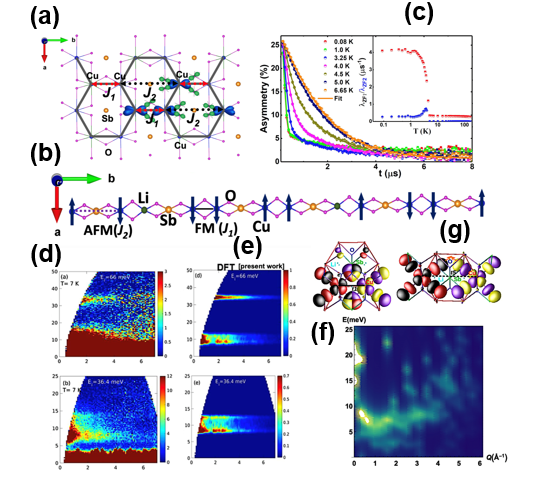Quantum spin liquids (QSLs) are solid magnetic materials that are unable to arrange their magnetic moments (or spins) into a regular pattern due to geometrical frustration. Finding QSL materials is rare, and there are only a few candidates reported so far. They tend to be found in structures like the pyrochlore or kagome lattice, which have a frustrated triangular geometry.
A group of researchers has used muon spin relaxation and neutron scattering at ISIS to investigate the ground state spin dynamics of a form of Li3Cu2SbO6 that takes a disordered honeycomb structure. They discovered a novel and unusual spin state, which does not reveal any magnetic ordering, even at temperatures as low as 50 mK.
Oxide materials like Li3Cu2SbO6 that take a honeycomb structure are attracting a lot of research interest, as they are good candidates for next-generation cathode materials for battery applications. They are made up of alkali metal atoms sandwiched between honeycomb layers made of transition metals and elements from Group 15 or 16 on the periodic table.
 Using MuSR, the researchers saw that the zero field musr-spectra down to 80 mK showed the absence of long range ordering. To confirm this, they measured the sample using neutron diffraction on WISH, and saw the absence of magnetic Bragg peaks at 50 mK, further ruling out any long-range magnetic ordering.
Using MuSR, the researchers saw that the zero field musr-spectra down to 80 mK showed the absence of long range ordering. To confirm this, they measured the sample using neutron diffraction on WISH, and saw the absence of magnetic Bragg peaks at 50 mK, further ruling out any long-range magnetic ordering.
Their study, published in Phy. Rev. B, suggests that, despite relatively strong antiferromagnetic interactions in the material (when spins are pointing in opposite directions), a QSL ground state is formed in Li3Cu2SbO6.
They expanded their study to use inelastic neutron scattering on Merlin to further investigate the magnetic excitations. Supported by theoretical modelling, they were able to explain the observed magnetic excitations using the linear spin wave theory and Exact Diagonalization method.
This study and its discovery of a QSL ground state in this type of materials offers up the potential for a wide range of other possible QSL candidates to be found.
Figure: (a-b) Crystal structure, (c) µSR spectra, (d) INS spectra, (e-f) Theoretical simulations and (g) Orbitals pictures.
Further information
